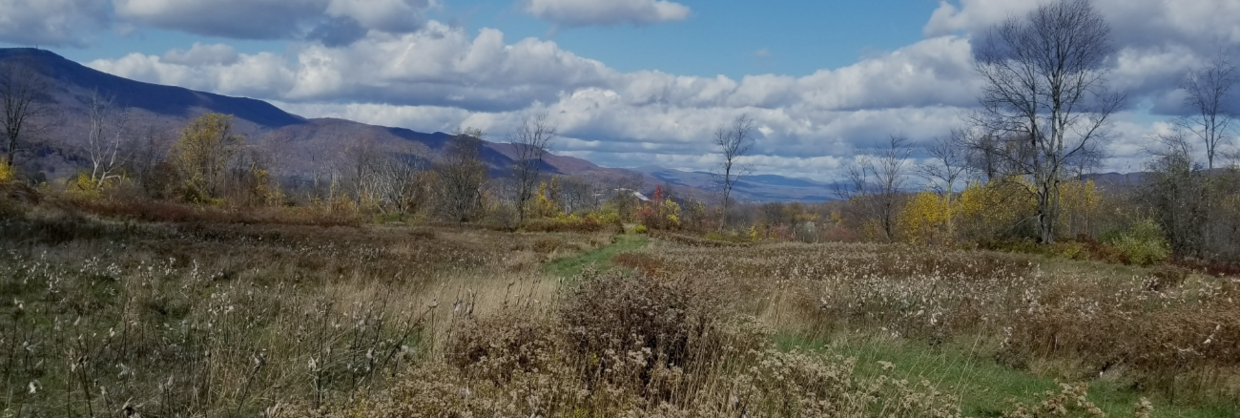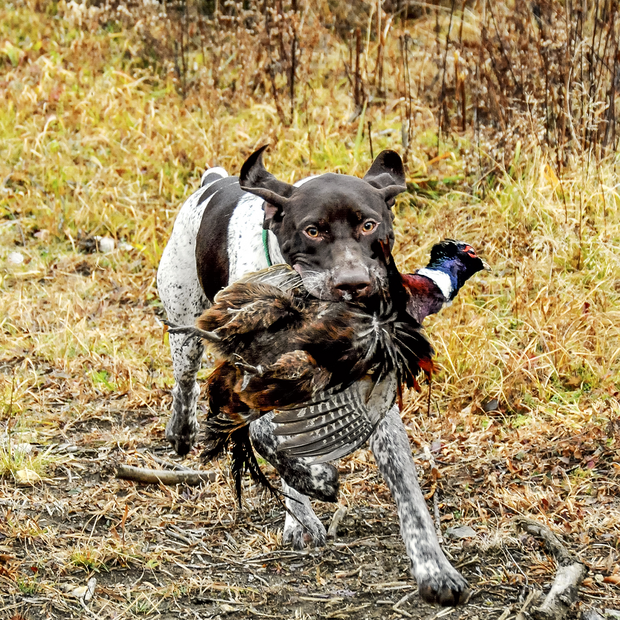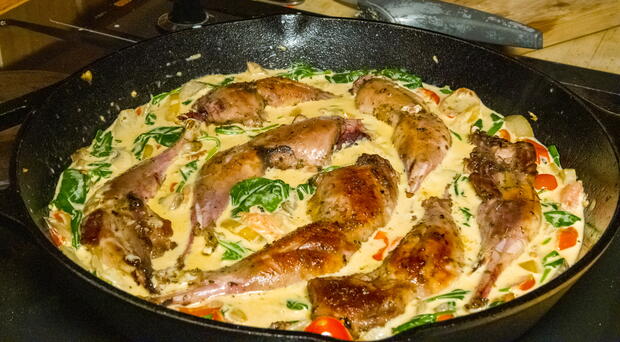Where to hunt
Go to Mass.gov/pheasant to see a map of locations stocked with pheasants during the season.
Shotguns, ammunition, and chokes
Shotguns
The best shotgun to use is the shotgun that works best for you—a pump, autoloader, over-under, side-by-side, or single-shot will work. The most common shotguns are 12 and 20 gauge.
Ammunition
The shotgun shells you use must be substantial enough to bring down a pheasant. If you are using lead shot, #4–#6 shot size will be effective. Nontoxic shot options like steel or tungsten are also available. Depending on the type of shot used, you may need to upsize or downsize the pellet size to find the optimal lethal load for pheasant hunting.
Chokes
An improved cylinder choke or modified choke is a versatile choice for pheasant hunting.
Practice
Wing-shooting flushing game is much different than aiming a rifle, muzzleloader, or shotgun at a stationary target. Hunters need to aim and shoot out in front of the bird (“lead the bird”) and follow through. The moving bird will then fly into the pattern and result in a lethal shot.
Patterning your shotgun and practicing by shooting trap or skeet will substantially increase your odds of success in the field. Patterning your shotgun will help you understand how a particular shot shell and choke combination performs (how tight or spread out the pattern). Practice shooting trap or skeet will also help you get used to hitting a moving target.
Tips for hunting with a dog
Pointers, flushers, retrievers, or other versatile hunting dog breeds can be a major asset when searching for pheasants. Some dogs that are not classic hunting breeds can also find their way around the pheasant covers and flush a bird or two. Dogs cover far more ground, can negotiate very dense thickets, and have a great ability to follow the scent of pheasants on the ground. The better trained and conditioned the dog is, the better experience the hunter and the dog will have. You may find that pheasants are the perfect excuse to spend more time together training. Here are a few tips that can make for a safe, enjoyable, and successful day in the field with your dog:
- Bring water. Make sure to have a bottle of water for yourself and your dog. Collapsible water dishes work great for a quick rest in the field.
- Get your dog a sturdy, blaze orange upland vest. This will help protect your dog as they push through heavy cover looking for pheasants.
- Attach a bell or electronic collar to your dog so you know their location. GPS collars are also available if you want to track your dog’s exact location.
- Trust your dog’s nose! If there is a thicket or hedgerow where you are hunting, work the downwind side of the cover. Remember, dogs are often relying on smell, so wind direction is important.
Tips for hunting without a dog
Even if you don’t have a dog, you can still enjoy pheasant hunting. You will need to alter your approach slightly. Pheasants and other upland game birds rely heavily on camouflage, it is easy to walk right by a bird on the ground. Pausing for 5-10 seconds regularly while walking through cover can make the pheasant react as if it has been spotted. Be prepared for the bird to flush when you start to move again.
Some other tips to get you started:
- Wear gear that will allow you to get into the thick cover where birds are often holding: brush pants, heavy jacket, gloves etc.
- Look for the distinctive colors and listen for the raspy cackling crow of a cock pheasant.
- Stay covered while stalking. Use trees and stone walls to stay out of sight.
- Zig zag in erratic patterns in stocked fields. Vary your speed and stop to look and listen.
- Stopping can trick a bird into thinking you see them and initiate a flush.
- Work adjacent fields to where hunters are working dogs. Let their work push birds toward you.
- Take hip waders to areas that is typically too wet to access or target other areas that may be overlooked by hunters, such as mature forested areas, wetlands.
What to wear
A blaze orange cap is required when hunting pheasants in Massachusetts, and it’s a good idea to wear even more orange. Find out more.
- It can be useful to have a vest to carry extra shells, a water bottle, and first aid kit. Many vests also have a pouch to store harvested game while you continue to hunt. Upland vests come in a range of shapes, sizes, and price ranges.
- While you can get by without them, brush pants or chaps are great for pushing through heavy cover and offer extra protection against thorns.
- Protect your dog from thorns and thick brush with a good upland vest.
- Upland hunters can expect to put some miles on their boot treads searching for pheasants. A good pair of comfortable boots that can withstand thick brush and thorns is essential. If possible, get waterproof boots to be ready for walking through wet grass and shrubs.
Safety tips
- Wear a blaze orange cap and other blaze orange clothing.
- Practice by shooting trap or skeet prior to and throughout the season.
- Never shoot a low flying pheasant; instead watch where the bird lands and flush it again.
- Never shoot out of your safe zone of fire.
- Bring water and first aid kit.
- Let someone know where you will be hunting.
- Wear insect repellant or insect repellant clothing to protect against ticks, treat your dog to prevent tick bites and thoroughly examine them after hunting.


